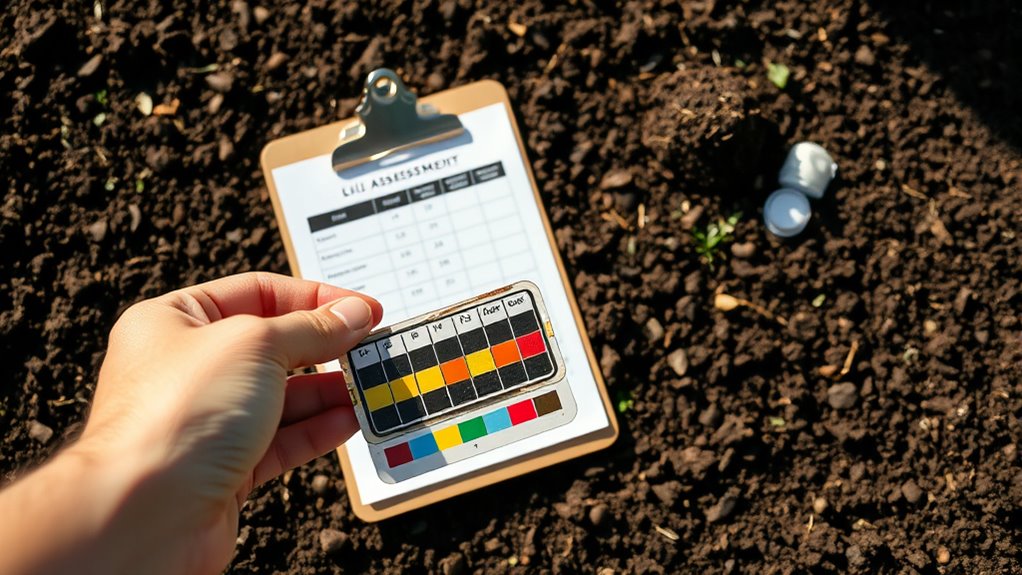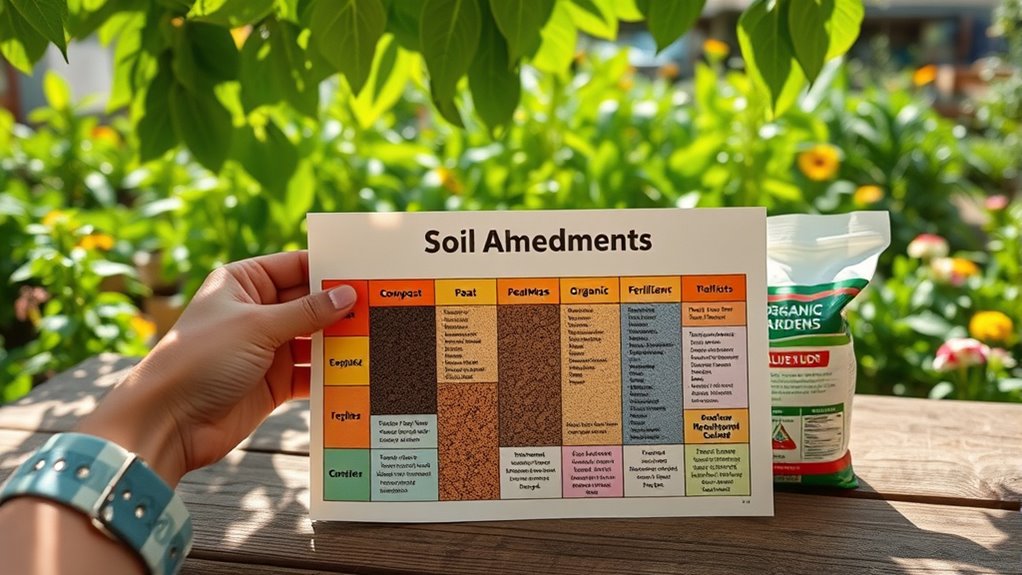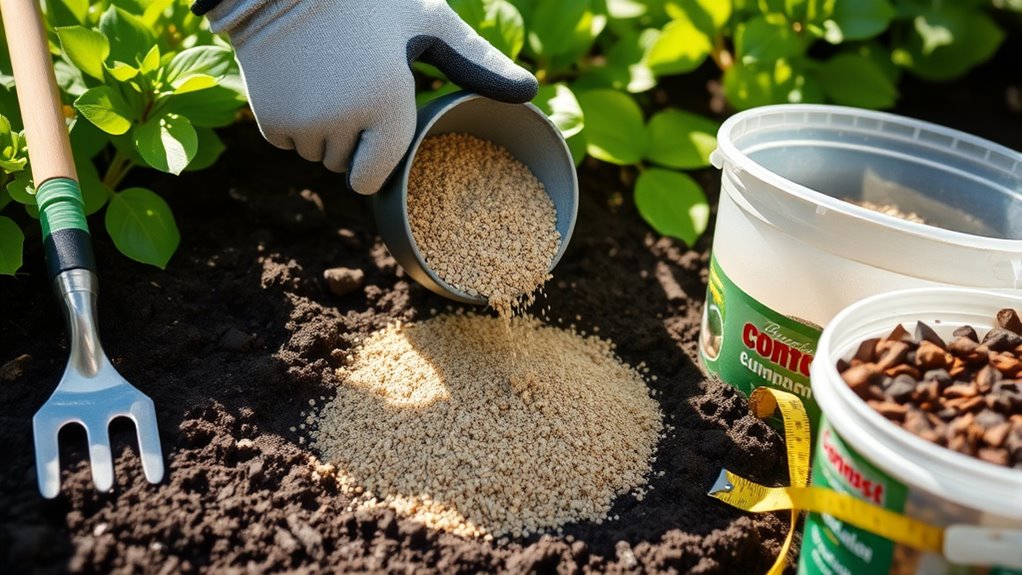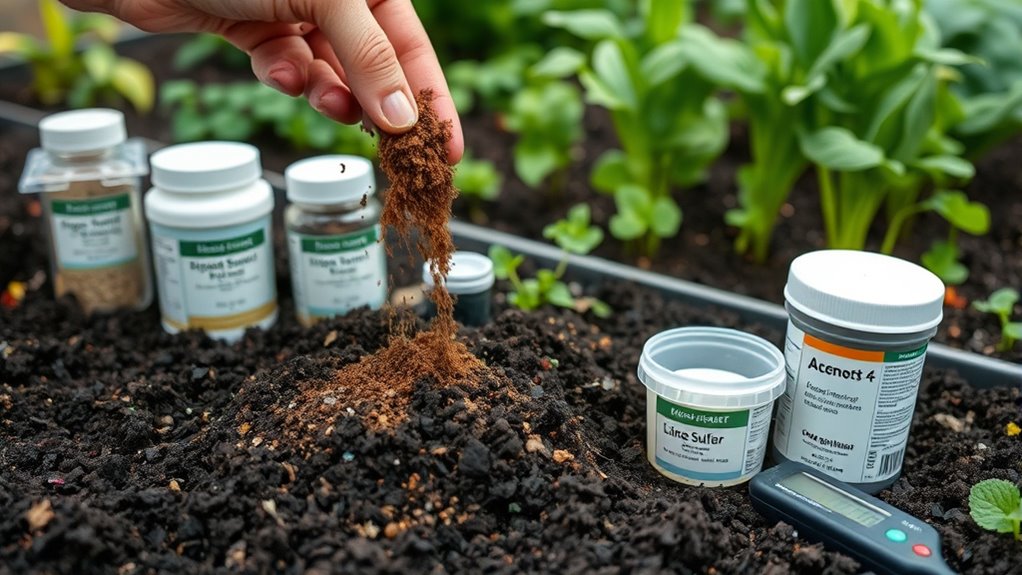To create a complete soil amendment checklist, start by testing your soil for pH, nutrients, and structure to identify deficiencies. Then, choose appropriate amendments like compost or synthetic fertilizers based on your soil’s needs. Apply amendments properly, avoid overdoing it, and monitor how your plants respond. Regularly evaluate your soil health and replenish nutrients over time. Keep these steps in mind; you’ll discover more tips to guarantee your garden’s success.
Key Takeaways
- Conduct thorough soil testing to identify deficiencies and determine suitable amendments.
- Choose organic or synthetic amendments based on soil needs, plant requirements, and long-term goals.
- Apply amendments during optimal conditions, following proper methods and manufacturer instructions.
- Monitor plant response and soil health regularly to adjust amendments and maintain balance.
- Maintain soil fertility through ongoing testing, composting, cover cropping, and erosion control practices.
Assess Your Soil’s Current Condition

Before adding any amendments, it’s essential to understand your soil’s current condition. Start by testing your soil to determine its pH, texture, and nutrient levels. This helps identify which compost types will best improve your soil. Different composts, like composted manure or leaf mold, offer specific nutrients and organic matter to support plant growth. Consider how your soil is layered; a well-structured soil should have a balanced mix of topsoil, subsoil, and organic matter. If your soil is compacted or lacks organic material, adding the right compost can improve aeration and drainage. By evaluating these factors, you’ll know exactly what amendments are needed, ensuring your garden gets the nourishment it requires for healthy growth. Additionally, understanding your soil’s structure and drainage can help select the most effective amendments to enhance plant health.
Identify Your Garden’s Nutritional Needs

To effectively determine your garden’s nutritional needs, you should analyze your soil’s nutrient levels through testing. Soil tests reveal deficiencies or excesses of key nutrients like nitrogen, phosphorus, and potassium, guiding your amendment choices. Once you know what’s lacking, you can select appropriate amendments to optimize plant growth. Proper watering techniques also influence nutrient availability; overwatering can leach nutrients away, while underwatering hampers absorption. Additionally, healthy plants are less prone to pests, reducing the need for pest control interventions. By understanding your soil’s current state, you can tailor your amendments accurately, promoting robust growth and minimizing pest problems. Conducting regular soil health assessments helps maintain balanced nutrient levels and supports overall garden vitality. This proactive approach ensures your garden receives balanced nourishment, leading to healthier plants and better yields.
Choose the Appropriate Soil Amendments

Before selecting soil amendments, it’s essential to understand your soil’s current condition through testing. This helps you choose between organic options and synthetic products that best meet your garden’s needs. Knowing the differences ensures you make informed decisions that support healthy, productive plants.
Soil Testing Importance
Have you ever wondered how to guarantee your soil has the right nutrients for healthy plant growth? Soil testing is essential because it provides accurate information about your soil’s nutrient levels and pH. Using soil testing methods, you can determine exactly what amendments are needed, avoiding guesswork. Soil testing tools, like test kits or professional lab services, make this process straightforward. These tools help you identify deficiencies or imbalances that could hinder plant development. By understanding your soil’s current condition, you can select the most effective amendments, saving money and preventing over-application. Regular testing ensures your soil remains ideal for growth, ultimately leading to healthier plants and better yields. Proper testing also helps you choose the appropriate soil amendments, ensuring optimal plant health and productivity. Don’t skip this step—testing is the key to informed, successful soil management.
Organic vs. Synthetic
Ever wondered whether organic or synthetic amendments are better for your soil? Organic options, like composting benefits, improve soil structure and boost microbial activity naturally. They release nutrients slowly, supporting long-term soil health. On the other hand, synthetic nutrients provide immediate nourishment but come with drawbacks, such as potential runoff and nutrient imbalance. Choosing the right amendment depends on your goals; organic amendments promote sustainability and soil vitality, while synthetics can quickly correct deficiencies. Be mindful of synthetic nutrient drawbacks, which can harm beneficial soil organisms over time. Combining both methods strategically can often yield the best results, but prioritizing organic amendments tends to foster healthier, more resilient soil in the long run. Ultimately, understanding these differences helps you make informed, effective choices for your garden. soil health is also influenced by proper soil testing and management practices.
Understand Organic vs. Synthetic Options

Understanding the difference between organic and synthetic soil amendments is essential for making informed gardening choices. Organic options, like compost options, improve soil naturally, boosting microbial activity and nutrient levels over time. Synthetic fertilizers, on the other hand, provide immediate nutrients but lack long-term soil health benefits. Consider the table below to compare these options:
| Aspect | Organic Options | Synthetic Options |
|---|---|---|
| Nutrient Release | Slow, sustained release | Quick, immediate absorption |
| Soil Impact | Enhances soil structure and health | May degrade soil over time |
| Example | Compost, bone meal | Synthetic fertilizers |
Choose organic for long-term health or synthetic for quick results, depending on your garden’s needs. Soil health is a critical factor that influences plant growth and sustainability.
Determine the Correct Application Methods

Selecting the correct application method is crucial to guarantee your soil amendments deliver maximum results. Proper fertilizer application ensures nutrients reach plants effectively without waste or runoff. When considering amendment timing, apply amendments when soil conditions are ideal—such as avoiding rain or extreme heat—to maximize absorption. You might choose broadcasting, mixing into the soil, or targeted spot treatments, depending on your amendment type and garden setup. For organic amendments, incorporate them well before planting to allow decomposition. Synthetic fertilizers can be applied in smaller doses more frequently, following manufacturer instructions. Always consider your soil’s current condition and your plants’ needs to determine the best method. Proper application techniques help your amendments work efficiently, saving you money and supporting healthy plant growth. Additionally, understanding soil health can guide you in choosing the most effective amendment strategies for long-term garden success.
Monitor Soil Changes and Plant Responses

You should regularly check your soil’s pH levels to confirm amendments are working effectively. Keep an eye on how your plants grow and respond over time, noting any changes in health or vigor. Recording these observations helps you determine if your amendments are truly improving your soil and plant performance.
Track Soil Ph Levels
Tracking soil pH levels is essential for maintaining healthy plants and ensuring ideal growth. When you monitor soil acidity, you can make informed decisions about pH balancing and amendments. Regular testing helps you catch shifts in pH that could hinder nutrient uptake or harm your plants. Use a reliable soil test kit and record your results to observe trends over time. Proper filtration of soil amendments can also improve their effectiveness and prevent issues in your soil management routine.
Observe Plant Growth Patterns
Monitoring plant growth patterns provides valuable insights into how soil conditions affect your plants. By observing changes such as plant height, leaf color, and overall vigor, you can gauge whether your soil amendments are working. If plants grow steadily and exhibit healthy foliage, it indicates that your soil amendment timing is appropriate. Conversely, stunted growth or yellowing leaves may signal nutrient deficiencies or imbalances, prompting you to adjust your approach. Regularly tracking these responses helps you identify the right moments to apply amendments for ideal results. Pay close attention to subtle shifts in growth patterns, as they often reveal important clues about soil health. Staying observant ensures you make timely, informed decisions to improve soil conditions and support robust plant development. Additionally, understanding how soil amendments influence nutrient availability can help optimize your plant care strategies during the second trimester.
Record Amendments Effectiveness
How can you determine if your soil amendments are truly effective? The key is to monitor soil quality changes over time and observe plant responses. Regularly testing your soil helps you track improvements and identify if adjustments are needed. Keep detailed records of amendment frequency to see how often you apply nutrients or organic matter and how that correlates with soil health. If you notice enhanced soil structure, increased nutrient levels, and healthier plants, your amendments are working. Conversely, stagnant or declining soil quality indicates you may need to modify your approach. Consistent monitoring allows you to fine-tune your amendment schedule and ensure you’re supporting ideal plant growth. Recording these observations helps you make informed decisions, maximizing your soil’s potential. Incorporating soil testing methods can further enhance your ability to evaluate amendment effectiveness accurately.
Maintain and Replenish Soil Health Over Time

To keep your soil healthy and productive over time, it’s essential to adopt practices that replenish its nutrients and improve its structure. Implementing effective composting techniques adds organic matter that boosts soil fertility and promotes healthy microorganisms. Regularly mulching and planting cover crops help prevent soil erosion, maintaining the soil’s top layer and preventing nutrient loss. Avoid over-tilling, as it can disturb soil life and increase erosion risks. Test your soil periodically to identify deficiencies and adjust amendments accordingly. Incorporate organic amendments like compost or manure to continuously enhance soil quality. Additionally, understanding celebrity transformations can inspire innovative approaches to maintaining a dynamic and resilient garden. By staying proactive with composting and erosion control, you support long-term soil health, ensuring your garden remains vibrant and productive season after season.
Frequently Asked Questions
How Often Should I Test My Soil for Nutrient Levels?
You should test your soil for nutrient levels at least once every one to three years, depending on your gardening or farming practices. Regular soil testing helps you understand the nutrient availability and avoid deficiencies or excesses. If you’re making significant changes or using new fertilizers, test more frequently. This way, you can adjust your soil amendments effectively, ensuring ideal plant growth and soil health over time.
Can Soil Amendments Improve Drainage and Aeration?
A stitch in time saves nine, and improving your soil structure can make a big difference. Soil amendments like organic matter boost aeration and drainage by loosening compacted soil. Adding compost or biochar enhances porosity, allowing roots to breathe and excess water to drain efficiently. Regularly incorporating organic matter not only improves drainage but also enriches soil health, creating a thriving environment for your plants to grow strong and healthy.
Are There Specific Amendments for Ph Adjustment?
Yes, you can use specific amendments for pH balancing. Lime application is a common method to raise soil pH if it’s too acidic. Conversely, sulfur or peat moss can lower pH if your soil is too alkaline. Regularly testing your soil helps you determine the right amendment, ensuring ideal pH levels for plant growth. Always follow recommended application rates to avoid over-correcting and harming your soil.
How Long Does It Take to See Results After Applying Amendments?
It’s like waiting for a volcano to erupt—results from amendments can take anywhere from a few days to several months. After applying amendments, you’ll want to check your soil test regularly. Usually, you’ll see noticeable improvements in pH or nutrient levels within a few weeks, but for full results, it’s best to follow the amendment timeline and give your soil time to stabilize. Patience pays off!
Are There Environmentally Friendly Alternatives to Synthetic Amendments?
Yes, you can use environmentally friendly alternatives like compost teas and biochar benefits. Compost teas boost soil health and microbial activity naturally, reducing the need for synthetic amendments. Biochar benefits include improving soil structure, retaining nutrients, and sequestering carbon. These options are sustainable, safe for the environment, and enhance your garden’s vigor without harmful chemicals, making them excellent choices for eco-conscious gardeners.
Conclusion
Just like a gardener tending to a treasured plot, you now hold the keys to vibrant, healthy soil. By evaluating, choosing wisely, and monitoring your amendments, you’re nurturing your own personal Eden. Think of it as channeling a bit of Mother Nature’s wisdom—like the careful hands that cultivate the Hanging Gardens or Versailles’ lush grounds. Keep at it, and your garden will flourish, proving that with patience and knowledge, even the smallest effort can grow something extraordinary.










